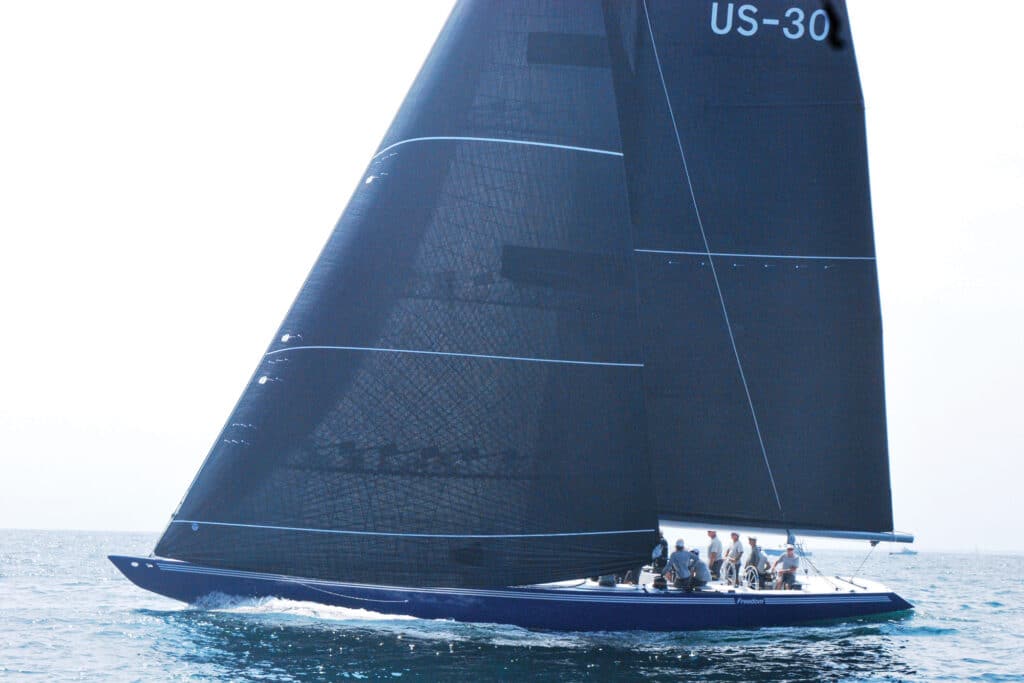
Forty years ago this past September, in the waters of Rhode Island Sound just off the coastal city of Newport, a crew of Aussies shocked the sailing world. The 12 Metre Australia II defeated the American boat Liberty to win the 1983 America’s Cup and bring the New York Yacht Club’s 132-year defense of the Auld Mug to a conclusion. It’s safe to say the Cup, and my hometown of Newport, have never been the same.
I spent a lot of time on the sound that summer taking in the action, so when I signed up to volunteer on a marshal boat for the latest edition of the 12 Metre World Championship regatta in August, I found myself on the very same waters, which turned into a pretty nostalgic voyage down a nautical memory lane. But the graceful Twelve I couldn’t take my eyes off wasn’t the winner of the Modern Division, Challenge XII, or even the victor of the Traditional/Vintage Division, Columbia. Nope, I was more or less transfixed on the runner-up to Challenge XII, a striking-blue yacht called Freedom. Of all the entries in the 10-boat fleet, to me, Freedom was easily the most historic and memorable.
Three years before the Australians absconded with the Cup, in 1980, with the estimable Dennis Conner in command, Freedom won the contest in dominant fashion, and it seemed like the New York Yacht Club’s winning streak would go on forever. It was designed by the legendary naval architecture firm Sparkman & Stephens, which had drawn the lines of every Cup winner but one since 1936. Conner was back on the helm in the losing effort in ’83, but he would find redemption, winning the Cup back for the United States in Western Australia in 1987. But for S&S, Freedom marked the end of an illustrious era. The firm would never again create a Cup winner.
For the 12 Metre Worlds, ironically enough, the navigator aboard Freedom was a lanky old Aussie mate of mine called Grant Simmer, who’d served in the same capacity aboard Australia II for his country’s winning effort way back when. With the exception of the gray hair, he looked exactly the same.
This time, however, Simmer couldn’t work his magic. Unlike the America’s Cup, where boats compete in one-on-one match racing, the World Championship event is fleet racing, with everyone out on the track at the same time. It’s a different game. And Challenge XII had a ringer of its own: the president of North Sails, Ken Read, also a longtime America’s Cup veteran. As far as I was concerned, Freedom was easily the prettiest of all the Modern yachts. When push came to shove, though, it was no longer the fastest.
Today’s America’s Cup competition, conducted on closed-course race tracks in skittish foiling catamarans—about as far removed as possible from a stately 12 Metre racing in the open ocean—bears little resemblance to what the event looked like in the early 1980s. And Newport has undergone a radical makeover as well. The shipyards where the Cup boats used to reside between races have been replaced by condos and hotels, and the only real remaining trace of the America’s Cup is the boulevard of the same name. It’s a reminder that the only true constant in life is change.
But for a few afternoons last August, I could shut my eyes for a moment of reminiscence and open them up to see what I can only describe as a fleeting image of a bygone time. Freedom may be a footnote in the history of yacht racing, but the big, beautiful blue boat still looks powerful and fantastic all the same.









